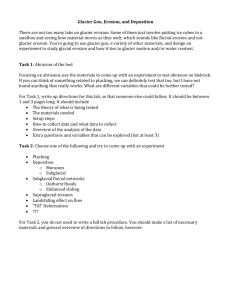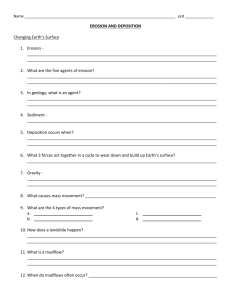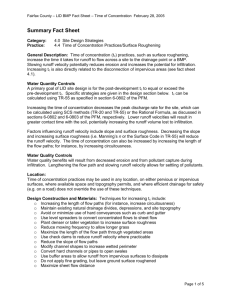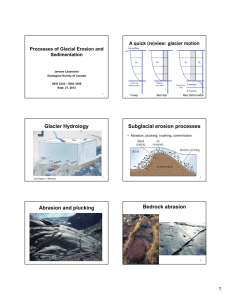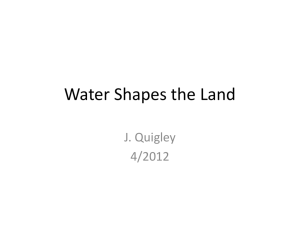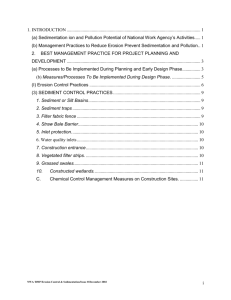Earth Science Chapter 9 – Erosion and Deposition
advertisement
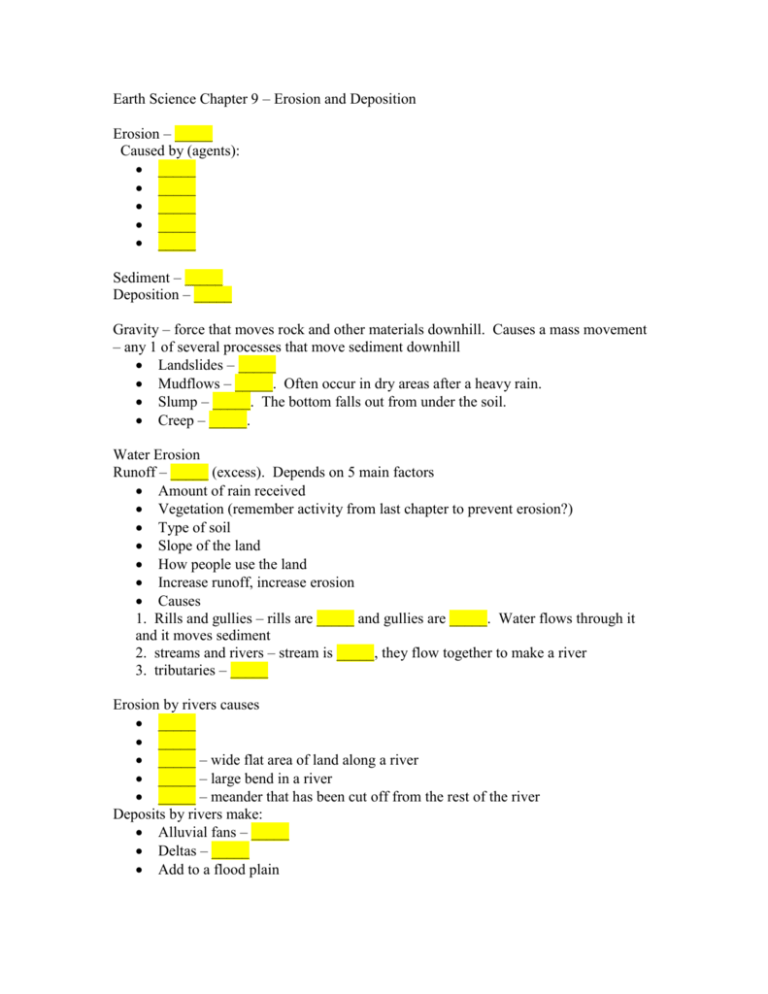
Earth Science Chapter 9 – Erosion and Deposition Erosion – _____ Caused by (agents): _____ _____ _____ _____ _____ Sediment – _____ Deposition – _____ Gravity – force that moves rock and other materials downhill. Causes a mass movement – any 1 of several processes that move sediment downhill Landslides – _____ Mudflows – _____. Often occur in dry areas after a heavy rain. Slump – _____. The bottom falls out from under the soil. Creep – _____. Water Erosion Runoff – _____ (excess). Depends on 5 main factors Amount of rain received Vegetation (remember activity from last chapter to prevent erosion?) Type of soil Slope of the land How people use the land Increase runoff, increase erosion Causes 1. Rills and gullies – rills are _____ and gullies are _____. Water flows through it and it moves sediment 2. streams and rivers – stream is _____, they flow together to make a river 3. tributaries – _____ Erosion by rivers causes _____ _____ _____ – wide flat area of land along a river _____ – large bend in a river _____ – meander that has been cut off from the rest of the river Deposits by rivers make: Alluvial fans – _____ Deltas – _____ Add to a flood plain Groundwater erosion Groundwater is _____ Cause erosion through chemical weathering Water + carbon dioxide = _____ Deposits cause stalactites and stalagmites (c=ceiling and g=ground) Limestone near groundwater at the surface can wear away and the overlying ground can fall through = sinkhole How water erodes Most sediment falls into a river as a result of mass movement and runoff. It can erode from the bottom of sides of a river. Abrasion – _____ (think about sand in the waves at your feet at the beach). Amount of sediment that a river carries is a _____ Ability of water to do this depends on 1. river slope – increase slope _____ flow and how much it carries 2. volume of flow – increase amount of moving water (such as a flood), increase _____ 3. shape of streambed – contact with sides and bottom of river _____ river flow. The rougher the sides the more turbulence there is (water flowing in many directions) 4. water moves slowly at the sides and sediment is deposited. If a river curves water moves fastest around the outside (erosion) and slowly around the inside (deposition). Glacier – large mass of ice that moves slowly over land Continental glacier – _____. When they cover very large parts of the Earth it is an ice age. Last one was 10,000 years ago. Valley glacier – _____. Form only in areas where more snow falls than melts. Once depth of snow and ice reach more than 30-40 m brevity begins to pull glacier downhill. Shaping the land Plucking – _____. Abrasion creates u-shaped valleys as rocks abraid the land underneath it. Till – _____ Moraine – _____ Kettle – _____ Lakes Drumlin – _____ Cirque – _____ Arête – _____ Horn – _____ Fiord – _____ Erosion by waves Impact of wave can break apart rocks over time, making small cracks larger Abrasion by sand carried by wave can erode the rocks Headland – _____ Sea stack Cliff Sea cave Sea arch Beach Spit Sandbar Wind – causes erosion by _____ and _____ (weakest agent) Sand dune – _____ (crescent or star shaped depending no how the wind blows) Deflation –_____ Loess – _____


